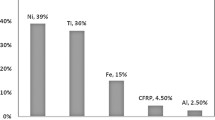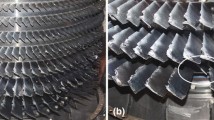Abstract
The largest single cause of component failures in modern military aircraft gas turbine engines is high cycle fatigue (HCF), exceeding the number attributed to low cycle fatigue, corrosion, overstress, manufacturing processes, mechanical damage, and materials. The HCF problem is a pervasive one, affecting all engine sections and a wide range of materials. In addition to the impact on engine component reliability, HCF problems cause significant economic impacts through field inspection and maintenance actions, and reduced readiness reliability.
This paper presents an overview, from an industry perspective, of the current, highly empirical approach for assessing the HCF capability. Complicating factors that must be addressed which affect engine HCF material capability are also described. Future directions which would improve the current approach are outlined, emphasizing incorporation of fracture mechanics. Technical challenges which must be addressed to successfully implement use of fracture mechanics for HCF are described, and areas of research recommended.
Similar content being viewed by others
References
N. Huber, ‘Plan to Control High Cycle Fatigue in Engines,’ presented at 1995 USAF Structural Integrity Program Conference, San Antonio, Texas, (28–30 November 1995), Document Release ASC 95–2510, WLPOTC, Wright Patterson Air Force Base, Ohio, 1995.
J. Goodman, Mechanics Applied to Engineering, Longmans, Green, and Co., London (1899).
C.G. AnnisJr., M.S. Mills and J.A. HarrisJr., Engine Component Retirement for Cause, Volume II Life Assessment Systems Development, AFWAL-TR-87–4069 Volume II, AFWAL/MLLN, Wright Patterson Air Force Base, Ohio, August 1987, pp. 59–78.
J.R. Zuiker and T. Nicholas, On high cycle fatigue design limits under combined high and low cycle fatigue, International Journal of Fatigue (1996).
M.A. McGaw, S. Kalluri, D. Moore and J. Heine, The Cumulative Fatigue Damage Behavior of MarM247 in Air and High Pressure Hydrogen, Second Symposium on Advances in Fatigue Life Time Predictive Techniques.
D.P. DeLuca and C.G. Annis, Jr., Fatigue in Single Crystal Nickel Superalloys, Final Contractor Report No. FR23800, United Technologies, Pratt & Whitney, Office of Naval Research, Contract N00014–91-C-0124, (1995).
T. Nicholas and J.R. Zuiker, On the use of the Goodman diagram for high cycle fatigue design, International Journal of Fracture 80 (1996) 219–235.
Air Force Aircraft Jet Engine Manufacturing and Production Processes, Report of the Ad Hoc Committee, United States Air Force Scientific Advisory Board, SAF/AQQS, the Pentagon, Washington DC 20330–1000, (July 1992).
Engine Structural Integrity Program (ENSIP), MIL-STD-1783 (USAF), 30 November 1984.
B.A. Cowles, Life prediction in high temperature environments: Overview of a current gas turbine engine approach, Materials Science and Engineering A103 (1988) 63–69.
D.P. Walls, R.E. deLaneuville and S.E. Cunningham, Damage tolerance based life prediction in gas turbine engine blades under vibratory high cycle fatigue, Transactions of the ASME, to appear.
F.K. Haake, G.C. Salivar, E.H. Hindle, J.W. Fischer and C.G. AnnisJr., Threshold Fatigue Crack Growth Behavior, WRDC-TR-89–4085, Materials Laboratory, Wright Research and Development Center, Air Force Systems Command, Wright-Patterson Air Force Base, Ohio, 1989.
Yoshiharu Mutoh, Mechanisms of fretting fatigue, Japan Society of Mechanical Engineers International Journal, Series A. 38:4 (1995) 403–415.
J.M. Larsen, B.O. Worth, C.G. Annis and F.K. Haake, An assessment of the role of near-threshold crack growth in high-cycle-fatigue life prediction of aerospace titanium alloys under turbine engine spectra, International Journal of Fracture 80 (1996) 237–255.
Author information
Authors and Affiliations
Rights and permissions
About this article
Cite this article
Cowles, B.A. High cycle fatigue in aircraft gas turbines—an industry perspective. Int J Fract 80, 147–163 (1996). https://doi.org/10.1007/BF00012667
Received:
Accepted:
Published:
Issue Date:
DOI: https://doi.org/10.1007/BF00012667




